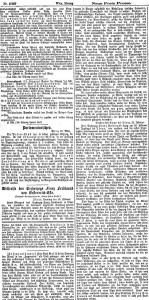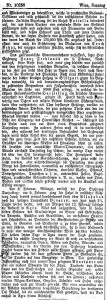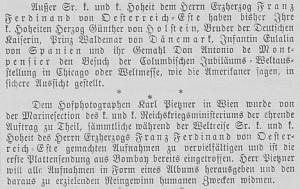From Agra we took in a North-western direction to Aligarh the East Indian Railway, from Aligarh in North-eastern respectively Eastern direction the Oudh and Rohilkund Railway. At 6 o’clock in the morning we arrived in Bareilly and turned into the narrow gauge line of the Rohilkund Kumaon Railway which took us to the terminal stop at Pilibhit from where our grand expedition to Nepal would start. The morning was clear and sunny. Just after we had left the station at Bareilly, the outlying mountains waved at us in a blueish haze. How happy I was to be able to greet mountains with green woods. Their sight lifted my spirits to the same elevated level as when I traveled towards Darjeeling. Soon emerged behind the outlying mountains the honorable peaks of the Himalaya mountains, gleaming white, full of ice and snow. A stark contrast — the yellow parched plain out of which rose the steep blueish gleaming outlying mountains and behind them, shining widely, the rising peaks of the Himalaya in majestic calm.
Already at 9 o’clock we arrived at Pilihhit where we were received by Mr. Macpherson, the collector of the district who supervised the arrangement for the transport to the camp. The closer we came to the Nepalese border, at first in carriages, the more luxurious became the vegetation until we drove through dense woods. A tree — shala tree (Shorea robusta), coveted for its wood — caught my attention due to its similarity to our oaks. Grass as tall as a human, as long as it had not been burned down, offered many excellent places to hide for the game as numerous clearings might suggest.
After each interval of about 10 km, the horses were switched and after around 30 km the wagons were exchanged for elephants. The road went, having crossed a clear deep stream, soon across thick grass jungles and patches of woods, soon past single large trees under which meager withered cattle spent their poor existence. Numerous skeletons and vultures circling above indicates that a large number of them dies in the open jungle.
Arrived at the Sarda river which forms the border between Nepal and the British territory, we were received by the English resident in Nepal, Colonel H. Wylie, who was in charge of our expedition. Along the shore of the river stood an impressive number of 203 elephants that would serve us as riding and driving animals during the whole of our Nepalese hunting expedition.
Having crossed the river, I inaugurated my hunting expedition. On a sand bank in the river, three huge crocodiles were laying there which I tried to approach in vain as they disappeared into the water before I was close enough to shoot. Instead I bagged a beautiful ruddy shelduck.
It was as strange as spectacular to watch the 203 elephants cross the border river in a row. The river carries clear mountain water, is deep and rapid, similar to our Enns or Steyr. The water reached up to the back of the tallest elephants. the smaller ones had to swim. Here too the elephants proved their intelligence in sloping diagonally against the strong current. Without accident did the caravan arrive on the left shore and now we were in Nepal, the hunting el dorado where we would spend three weeks as a free hunter. In an area barley touched by civilization, in the midst of the wilderness where nature knows no bounds, where everything develops, grows, perishes without the regulating hand of man. Here we would hunt predators and observe animal life in the jungle. Full of the best of hopes we stepped on Nepalese ground. We had looked forward to the expedition during our whole trip and during much festive occasion our thoughts went longingly to the hunting camp and the tigers.
The first impression already was very favorable and promising. The majestic landscape so different from the mostly monotone Indian plain — in the background mountains, jungle everywhere — and a tent camp to my heart’s content were expecting us. There were no flower ornaments, no gardens with water fountains, no stone and mosaic decorations. Each of us had a small practical tent with a bed, a chair and a table, enough space to store the baggage, rifles and munitions. Around the tents camped large number of shikaris, the elephant and camel drivers and coolies who had to set up and pull down the camps. There, under mighty trees that offered shade, on a spot the people called „Dakna Bagh“ we set up camp and were hospitably received.
The state of Nepal is a strange and usually little known country that borders in the north on Tibet, the large neighbor of China, in the west and south on the Indian Northwest Provinces, in the east on Sikkim. Like Bhutan, from which it is separated by Sikkim, Nepal has retained its independence up to the present day from the Anglo-Indian Empire which rules over the whole Himalaya area with the exception of Nepal and Bhutan and thus controls the strategically important passes to Turkestan and Tibet. This fact has not been changed by Nepal’s recognition of an English suzerainty nor has the presence of a large number of Nepalese warriors, Ghurkas, among the sepoys in the Anglo-Indian army — 15 percent of the whole sepoy contingent of 110.000 men according to the last census. These Ghurkas or Khas, as these sturdy warlike highlanders of East Nepal, the district Ghurka, are called without distinction about the different races they are part of, only serve outside the borders of their homeland and, a small contingent of 1500 men apart which are regulated by the treaty of 1888, they only serve as volunteers under the English colors.
The English count the wiry, agile, fast marching and persevering Ghurkas among their best troops. The English soldiers especially the Highlanders get along splendidly with their Nepalese comrades. They are said to be especially gutsy and brave and attack with cold steel, their sharp curved knives, a way of fighting they prefer to than anything else.
The British resident in Nepal has, compared to the large power of British residents in the other Anglo-Indian states, little externally visible influence. He is, for example, restricted to keep within a range of 25 km around the capital of Nepal, Katmandu. He is not allowed to venture beyond this limit without special arrangement. The roads from and to India is assigned to the resident by the maharaja. Anyhow Nepal by its location, formation and composition as well as the warlike nature of its inhabitants provides a very valuable fortress against any attacks to the Anglo-Indian Empire from the North-east, so that the British rulers of India do all in their diplomatic art to keep a good relationship with Nepal — which one day may still end with an occupation of this state.
The geographic location of Nepal is also very special. In the north, it borders on the large bare plateau between the Himalaya and the trans-Himalayan territory. It forms a 700 km long stretch that is but around 150 km wide. The northern border of it is protected by the main mountain range of the East Himalaya with Dhaulagiri as its western and Gaurisankar as its eastern end. The southern border of Nepal descends to the Ganges plain to the Tarai belt with its jungles and swamps.
Between the two borders, the actual place of Nepal seems to be a labyrinth of rocks, steep hillsides and deep gorges, in which only the outlying area of the Himalaya, the middle elevations of the mountains, the ridges and river valleys are inhabited and cultivated. In the numerous valleys that feed and fertilize the the rivers leading to the Ganges plains they practice terrace cultivation and grow barley and also wheat. In the area that descends towards India, even rice is grown. Some areas, like the around 20 km long circular valley in which lies Katmandu, the most important commercial place in the country, and Nayakot, the former winter residence of the princes of Nepal, are known for their subtropical vegetation, gorgeous fruit gardens and rich woods at higher elevations. Iron and copper wares as well as paper from the fiber Daphne cannabina, resins and other forest products, furs, opium, wool, cloth, salt, turquoise and gold powder, as well as small excellent horses and finally musk from the once numerous musk deer (Moschus moschiferus) are besides agricultural products the main goods produced and exported out of Nepal. Trade links are strong both with Tibet, as well as with Northwest India even though it is burdened by all kinds of tariffs and taxes and the transport of goods over many of the passes is very difficult. In the year 1892, imports to Nepal were valued at 11,759.314 fl. in Austrian currency and exports out of this country amounted to 10,071.685 fl. in Austrian currency.
The geographic set-up of Nepal is in its details still little known as the maharaja who has an understandable aversion to cartographic surveys impedes the entry of Europeans and especially of scientists. Seldom only has a scientist managed to enter here an the largest part of the roads in the interior of Nepal have been explored only by disguised Pandits sent by the Anglo-Indian government. These natives are used to survey and explore areas closed to Europeans.
The Area of the state is estimated to be around 154.000 km2, the number of its inhabitants — census has to be replaced here by estimate — approximatively 3 millions.
The inhabitants of Nepal are a mixture of peoples in which the Tibetan element predominates but one finds much Aryan blood too. Especially the Ghurkas, or Khas claim even if this mostly wrong, to be true Hindus and to be members of the warrior caste of the Kshatriya. The type of the Nepalese is almost exclusively Mongolian.
Of Tibetan origin were the princes too who were part of the Newar people who was, residing at Kirtipur next to Katmandu, were dethroned by the Ghurkas in 1707. The current ruling Ghurka house of Sahi claims to be descendants of the Rajput princes of Udaipur — whether this correct is another matter.
The Newars who live in the middle of the country around the capital are even today the most pure national element of Nepal. The political aspirations and the customs in the south and th west of the country are mostly of Hindu, the one in the north and east of Tibetan origin.
From 1792 on, after an unsuccessful campaign of the Ghurkas against Tibet, it was nominally part of the Chinese Empire for a short time and since then a tributary of it and has sought a close relationship with England which, however, led to bellicose complications with it (1814), which ended with the cession of the territories of Kumaon and Garwhal, all in the west of the country. The East-Indian company was also permitted at that time to engage in transit trade through Nepal to Tibet. Of Nepal’s history one must further mention the war they made on Tibet in 1855 and the enlargement of the Nepalese territory towards the Brahmaputra (1867).
In lieu of the current maharaja, still a minor, Adhiraj Bikram Jamshir Jang (born 1874), the first minister Bir Jamshir Jang Rana Bahadur assumes the responsibility of governing. The elevated rank of the minster in Nepal is said to be a dangerous and mostly short one as ministers die a violent death after they have been in office for some time. There are numerous small parties in Nepal and if the minister of one party has been inconvenient or his influence has become to strong according to some at the court, he is simply killed.
The maharaja has an army which consists according to newer sources of 17.000 regular soldiers equipped with Enfield rifles and 13.000 irregular troops. The income of the prince are around 11,550.000 fl. in Austrian currency.
The capital and residence city Katmandu, in its architecture almost completely of Tibetan origin, has 70.000 inhabitants and lies in the middle of the county, 144 km distant from the closest railway station.
The territory in which we were intended to hunt for two weeks is the above mentioned Tarai region, a small swampy plain between the border river of Nepal, Sarda, and the outlying mountains of the Himalaya and known for its wealth in forests. On the order of the maharaja, even the tigers are in some way spared. Not without difficulties is it possible to get a permission to hunt in this hunter’s paradise. Usually only every second or third year is a large hunting expedition mounted which travels across the region for a few weeks. In the last hunting expedition participated the since deceased Duke of Clarence; earlier the Duke of Orleans and, in the year 1875, the Prince of Wales have hunted here. The British resident of Nepal, whose intervention grants from time to time permission for English sportsmen to hunt in the border regions, stays often during the winter months here to try his luck in hunting.
Unfortunately the best hunting grounds of the country is notorious for the fever that is common there and scarcely populated as the population is being decimated by illnesses of all kind. The government does its utmost to repopulate the land, divides up land without charge and promotes establishments in all kinds of ways but up to now without achieving notable results.
Hunting expeditions of a size such as this one require to supply many humans and numerous animals which is especially difficult. We had to provide for 1223 men and 415 animals, including 203 elephants! If one considers that every day an elephant needs around 75 kg of straw or grass as well as bread and grains and that that food itself has to be transported from afar, one can conclude about the necessary size of the apparatus that can provide the daily provisions of the camp. The demands for our kitchen can only be met from Pilibhit, that is at a distance of 41 km, as the hunting grounds only supply what game we catch.
The arrangement of the hunts is organized by the resident together with an unle of the maharaja called Kesar Singh, and his son Prem Jamshir. The last one had been sent by the maharaja for this purpose.
As there was still time es when we arrived at Dakna Bagh, I asked to hunt in the surroundings of the camp. The resident then immediately ordered 50 elephants prepared for a hunt. In the area were we were one can only hunt with elephants as the jungle is much too high an thick for a pedestrian to penetrate or even drive out animals. On the order of „line“ all elephants assembled in a straight line in only a few moments, the animals standing pretty close together. The shooters in their haudas are placed at certain intervals. Despite some irregularities in the terrain and numerous obstacles the line advances at full speed almost as it is the case in a well organized rabbit hunt in Bohemia.
Negative is only the known difficulty of shooting securely out of the hauda. Usually the circumstances don’t permit to have the elephant come to a stop. Thus the shooter has to fire while the huge mass is in motion. Only if one shoots with a ball which would otherwise be too risky, one calls the mahaut with the word „Rok“ (Halt), even though, as we have already experienced before, the hauda keeps moving despite the elephant stopping his motion. Thanks to the practice in the earlier hunting camps I managed to fire after a few days even with balls from a walking elephant.
The hunter’s success is highly dependent on the mahaut and on his comprehension of the hunter’s intentions. With the help of my very limited vocabulary of Hindi — rok halt, deihne right, beine left, sidah straight on, bohut acha very good, chelao quick etc. — the shooter tries to make his desires understandable to the mahaut who translates the wishes if he agrees with them to the elephants with the help of different tools_ Shouts and admonitions, kicks with the legs behind the ears, hits with a stick or even pricks with a pointed Kaschwar. If the mahaut does not agree with the hunter, he often starts a long but to us incomprehensible speech which concluded in the mahaut’s will being followed. Any force to make the mahaut follow the hunter’s orders only creates all too quickly discontent and anger in the mahaut’s chest or has the man who knows about his own importance break out in loud laughter in which the other mahauts join in and use unmistakable gestures to show their contempt of the hunter. At the beginning the hunter is the object of much scrutiny by the mahaut. If the shooter shows himself competent in the use of the rifle and a good shot, he starts to trust him and do his best to help him shoot out of a good position.
The hunt undertaken yielded an Indian hog deer (Cervus porcinus), multiple vultures, falcons and francolins, as well as a jackal.
Enchanted by this splendid spectacle of the setting sun’s rays upon the dramatically illuminated mountains we returned to the camp when it became dark.
Links
- Location: Dakna Bagh, Nepal
- ANNO – on 08.03.1893 in Austria’s newspapers.
- The k.u.k. Hof-Burgtheater plays “Die Eine weint, die Andere lacht“, while the k.u.k. Hof-Operntheater is performing the opera „Die Rantzau“.



